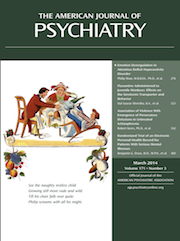This book presents a summary of some of the clinical findings of the Collaborative Depression Study, a 31-year longitudinal follow-up of patients with mood disorders treated in various settings. At the time this book went to press, the study had generated 285 research reports. The authors, who have participated in the study, do an excellent job of summarizing the mountain of data that has emerged from it. Each chapter ends with a brief summary of clinical implications of the findings.
An important finding of the Collaborative Depression Study that patients and astute clinicians have always known (but not always paid attention to) is that the standard definitions of response (50% improvement) and remission (depression or mania rating scale scores that are about two-thirds better but not zero), which are the primary outcome measures of the clinical trials on which we all base treatment choices, are not satisfactory outcomes. Most of us would not be satisfied with feeling better but not well, and any residual symptoms greatly increase the risk of major relapse and recurrence. Even mild, subsyndromal symptoms are associated with significant levels of impairment, which is an independent predictor of relapse. Indeed, the observation that “many individuals have residual subsyndromal symptoms and disabling psychosocial impairment when recovered from major episodes of depression for at least 2 months” (p. 169) indicates that the true meaning of “recovery” does not apply to many patients. The investigators point out that residual depressive symptoms deserve as much aggressive attention as the less common residual manic and hypomanic symptoms in bipolar disorder, and they suggest that antidepressants may not worsen the course of all cases of bipolar disorder. However, they are not yet able to reassure us about which bipolar disorder patients can and which cannot tolerate ongoing treatment with antidepressants. Despite the widely acknowledged need to treat mood disorders early and aggressively, to combine pharmacologic and psychological therapies, and to reduce the risk of relapse by continuing whatever treatment is effective acutely, mood disorders remain undertreated.
It will come as no surprise that past suicide attempts, especially those with high intent, increase the risk of suicide in the future, as do anxiety and substance abuse. The Food and Drug Administration and some professional groups should review data indicating that antidepressants not only do not increase the risk of suicide, but they reduce it. It may be less apparent that around one-quarter of patients with a diagnosis of major depressive disorder will go on to develop bipolar disorder. Risk factors for such conversion include psychotic symptoms, family history of bipolar disorder, early onset of depression, and subsyndromal hypomanic symptoms. Results of the Collaborative Depression Study suggest that it may be possible to treat alcoholism at the same time as mood disorders, but each active disorder makes the other more resistant to treatment.
Anyone who has passed the American Board of Psychiatry and Neurology oral examination knows not to diagnose a personality disorder in a patient with an active mood disorder, and the Collaborative Depression Study supports the belief that assessment of personality by the patient and others is state dependent. It may be less well known that the secular trend toward increased incidence of depression in more recent generations can skew estimates of the heritability of depression because parents tend to have a lower prevalence of depression than their children.
The Collaborative Depression Study has been at the forefront of psychiatric diagnosis throughout its course, and its findings include features of unipolar and bipolar disorders that alter course, such as anxiety, psychosis, and substance abuse. However, it relies heavily on the categorical diagnoses that have largely continued from DSM-IV to DSM-5. An enormous amount has been learned, but it is still not possible to determine whether patients with early-onset depression and a history of trauma, for example, have a different course and require different treatment approaches than other patients, or whether depressed patients who experience dissociation have a course similar to those with psychosis. And since most studies are of monotherapy or of combinations of a single medication with a single psychotherapy, we have no empirical guide to the combinations of therapies that are necessary for patients with more complex mood disorders. Yet the Clinical Guide to Depression and Bipolar Disorder offers the most current information that is available in a single place—and certainly the most readable source for investigators and clinicians. It is a clear springboard for the next generation of studies of mood disorders.

